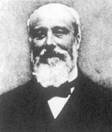Zhilin P.A. Mechanics of
Deformable Directed Surfaces. Int. J. Solids Structures. 1976. Vol. 12. P. 635-648.
On direct approaches to construction of the
shell theory
As a general rule, when speaking of the foundations of shell theory we think of the
following problems: a rational derivation of the basic equations of two-dimensional
shell theory from the equations of three-dimensional theory of elasticity; a
formulation of the boundary conditions; an estimate of the accuracy of the equations
so derived.
In so doing it is implicitly (and sometimes even explicitly) understood that the
shell theory should be an asymptotically exact result of the theory of elasticity.
However, difficulties already arise in defining a shell. The intuitive definition
of a shell — that of a body one dimension of which is very much smaller than the
other two — is obviously inadequate. In fact, it is also necessary to restrict the
class of permissible external loads. Moreover, the requirement that the shell
thickness be small is sometimes also superfluous. For example, the problem of pure
bending of a strip is described equally well by both the three-dimensional elasticity
theory and the two-dimensional shell theory, regardless of the thickness of the strip.
Besides, when seen from a distance, many engineering structures look like shells
and can, in fact, be considered as such, although it is impossible to define
a thickness in such cases. It may also be remarked that the definition of
a shell is not the main problem in the shell theory, but rather, the simplest
of the remaining problems in shell theory.
For these reasons, in the past decade or so, there has probably been a revived
interest in the construction of a shell theory through a direct approach based
on the concept of directed deformable surfaces. The theory of such surfaces
contains all the basic elements inherent in the shell theory, yet it does not
coincide with the latter. Like the shell theory, the theory of directed deformable
surfaces is based on the concepts of forces, couples, displacements and rotations
that arc specified on a two-dimensional manifold. However, in contradistinction
to the shell theory, these concepts are introduced a priori into the theory
of directed surfaces which makes it possible to avoid the contradictions
inherent in the shell theory. This is undoubtedly a great merit of the theory
of directed surfaces, provided, however, that it is able to cover a lot of the
problems considered in the shell theory. The limits of validity of the theory of
directed surfaces are as yet essentially unknown. To answer this question it will
be necessary to solve the same problems as arise in constructing a shell theory.
However, the construction of a theory and the determination of the range of its
applicability differ significantly from each other. Whereas the question regarding
the construction of the theory proper can and must be answered exactly, the same
cannot be said of the latter question. The major stumbling block in the classical
shell theory is probably that these two problems are mixed.

|
|
| L.Euler |
The use of a direct approach to constructing a theory of bars and shells can be
traced back to Euler. Later, Dühem introduced the idea of directed spaces that was
subsequently developed by E. and F. Cosserat. However, further development of the
shell theory took a different path. It was only much later that a paper by Ericksen
and Truesdell dedicated to the memory of the Cosserat brothers, again directed the
attention of workers towards seeking a direct approach to the construction of
a shell theory. Beginning in 1965, Green and Naghdi published a number of papers
devoted to this subject. These authors developed a general non-isothermal theory
of directed surfaces and pointed out one of the many ways of interpreting the
quantities that are introduced a priori into such a theory, and thus illuminated
a path leading from the theory of directed surfaces to a theory of shells.
A somewhat different approach to this problem has been presented by Reissner, who,
however, considers it in a more restricted formulation that is very close to the
linear theory of elastic shells.
 |
|
| Dühem |
The essence of the present work is very close to the works by Green and others.
However, it differs from the latter, not only in purely technical details, but also
as follows. Firstly, in the choice of the directors as a triad of vectors and hot
as a single vector. (The three vector theory has been developed in a paper by Cohen
and DeSilva). To this end, the present work gives a general description of the
kinematics (Section 1) and the dynamics (Section 2) of a surface with such a director.
Secondly, in the formulation of the second law of thermodynamics as two inequalities
of Clausius-Dühem type (Section 3). This makes it possible to include the temperature
drop along the shell thickness. Thus, Section 4 presents the constitutive equations
and stress-strain-temperature relations for the nonMsothermal theory of a directed
surface. Thirdly, in the formulation of the constitutive equations for linear coupled
thermo-elasticity and in the determination of their structure. In doing so, we
follow arguments similar to those of Niordson and Serbin. Lastly, in the determination
of the elastic moduli. In this connection, it is worth pointing out that we do not
use the conventional interpretation of the displacements, forces and couples in a
shell as being some average of the corresponding quantities in a three-dimensional
continuum. Specifically, we utilize the implicit averaging properties of frequencies
of natural vibration, which, in contradistinction to displacements, rotations, forces
and couples, are characteristics of the mechanical system as such and not of its
deformed state.


